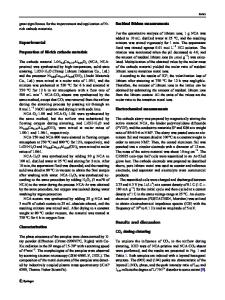Novel Cathode Materials Based on Organic Couples for Lithium Batteries
- PDF / 682,011 Bytes
- 11 Pages / 414.72 x 648 pts Page_size
- 33 Downloads / 393 Views
layered structure and provide good capacities in cycling ( 130- 150 mAh.g-1 respectively), with a discharge plateau being near 4V. The high cost of LiCoO2 and the difficulty to synthesize LiNiO 2 in its electrochemically active structure make LiMn 204 more attractive. LiMn204 is generally described as an inexpensive and rather "green" material. Thus the LiMn2O4 spinel phase has been extensively studied and considerable amount of work has been focused on the optimization of this material. Today, the reversible capacity on the 4V range is almost the same as for LiCoO2 [I(]. A synthesis of LiMnO2 having the same layered structure 1 than LiCoO2 has been recently reported 19-111. The initial capacity announced is 270 mAh.g- but 2 the cycling performance of this material is unsatisfactory. Mn + can dissolve in the electrolyte and all 4V materials exceed the stability windows of known electrolytes, raising safety issues. An interesting recent development is the use of compounds with olivine structure such as LiFePO 4 [12] or with a NASICON framework such as LiFe2(SO4) 3 [13]. In both cases, lithium 1
insertion occurs close to 3.6 V vs. Li+/Li' with a reversible capacity =-100 mAh.g- at low discharge current densities. Increasing the current densities leads to a loss of capacity. Quinones are well known to give reversible redox couples in aqueous solutions and probably the most ubiquitous mediators in biological systems. In nonprotic media, radical anionic species are involved but the potentials tend to be rather low (= 2.2 V vs. Li+/Li0 ) and in the neutral form, they tend to be soluble in the electrolyte media [141. In the present paper, we report on our studies on the electrochemical behavior in all solid state lithium cells of a novel family of cathodic materials based on organic compounds : the oxocarbons. The term oxocarbon designates a series of compounds in which all, or by extension nearly all, the carbon atoms are bonded to carbonyl or enolic oxygens as well as their hydrated or deprotonated equivalents. The most important oxocarbons are the cyclic compounds CnOnx- such as the four, five and six carbons rings : squarate, croconate and rhodizonate.
0
0 01
0o, squarate
0
"0
%
0
0
0
croconate
rhodizonate
The stability of these compounds decreases when the number of carbons increase. This is the reason why the seven or eight member rings have not been reported. The chemistry and the main features of oxocarbons are summarized in reviews [15 - 18]. Oxocarbons are known since the early years of the 19th century and probably predate the transition from inorganic to organic chemistry by Wohler [191. Though, the aromatic nature of the monocyclic oxocarbons anions was recognized less than 30 years ago 1201. More recent studies [21] tend to question this point and claimed that for monocyclic anions the aromaticity decreases rapidly with increasing ring size. Nevertheless, these anions are stabilized by delocalization of 7Eelectrons at the ring periphery. Crystallographic and spectroscopic studies show a symmetr
Data Loading...











